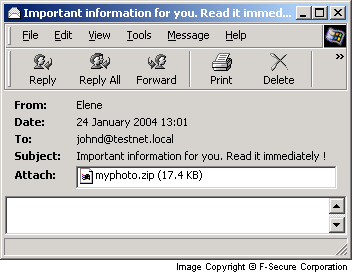Dumaru.Y
Summary
A new variant of the Dumaru worm family has been found in the wild on 24th of January, 2004.
Dumaru is a family of mass-mailing worms that feature various backdoors and data stealing features.
Removal
Dumaru-Y can be removed manually by performing the following steps:
-
1, Delete the registry value:
- HKLM\Software\Microsoft\Windows\CurrentVersion\Run\load32
-
2, Delete the files:
- %SysDir%\l32x.exe
- %SysDir%\vxd32v.exe
- dllxw.exe from the Starup Directory
-
3, Restore 'system.ini' to
[Boot] Shell=explorer
- 4, Restart the computer
A False Positive is when a file is incorrectly detected as harmful, usually because its code or behavior resembles known harmful programs. A False Positive will usually be fixed in a subsequent database update without any action needed on your part. If you wish, you may also:
-
Check for the latest database updates
First check if your F-Secure security program is using the latest updates, then try scanning the file again.
-
Submit a sample
After checking, if you still believe the file is incorrectly detected, you can submit a sample of it for re-analysis.
Note: If the file was moved to quarantine, you need to collect the file from quarantine before you can submit it.
-
Exclude a file from further scanning
If you are certain that the file is safe and want to continue using it, you can exclude it from further scanning by the F-Secure security product.
Note: You need administrative rights to change the settings.
Technical Details
System Infection
Upon execution Dumaru.Y installs several copies of itself to the computer:
-
'l32x.exe' to the Windows System Directory which is added to
the registry as
HKLM\Software\Microsoft\Windows\CurrentVersion\Run\load32
- 'dllxw.exe' is copied to the current users' Startup Directory.
-
'vxd32v.exe' to the Windows System Directory which is added
to the system.ini:
[Boot] Shell=explorer vxd32v.exe
Email Propagation
Dumaru.Y uses its own SMTP engine to send emails. The SMTP engine performs a direct name service lookup on the target domain so it does not depend on the infected computer's email server settings.
To collect email addresses the worm recursively searches through all the directories on the computer and looks for files that could contain email addresses:
'.htm' '.wab' '.html '.dbx' '.tbb' '.abd'
Going through the list of collected addresses Dumaru.Y sends emails with infected attachments that have to following characteristics:
From: "Elene" [F*CKENSUICIDE@HOTMAIL.COM] To: [user@targeted.somewhere] Subject: Important information for you. Read it immediately ! Body: Here is my photo, that you asked for yesterday. Attachment: myphoto.zip

Payloads
Dumaru.Y contains several backdoor and data stealing components as payload.
Backdoors
Dumaru.Y installs an FTP server to TCP port 10000 which provides unrestricted FTP access to all the files on the infected computer.
On port 2283 a TCP forwarding proxy is listening which can be used by remote attackers to initiate connections through the infected computer.
Data stealing
Dumaru.Y - just like it's earlier variants - comes with capabilities to steal sensitive user data:
- clipboard data
- Protected Storage Data
- User credentials and key log data of visits to www.e-gold.com
The collected data is sent to a predefined email address.